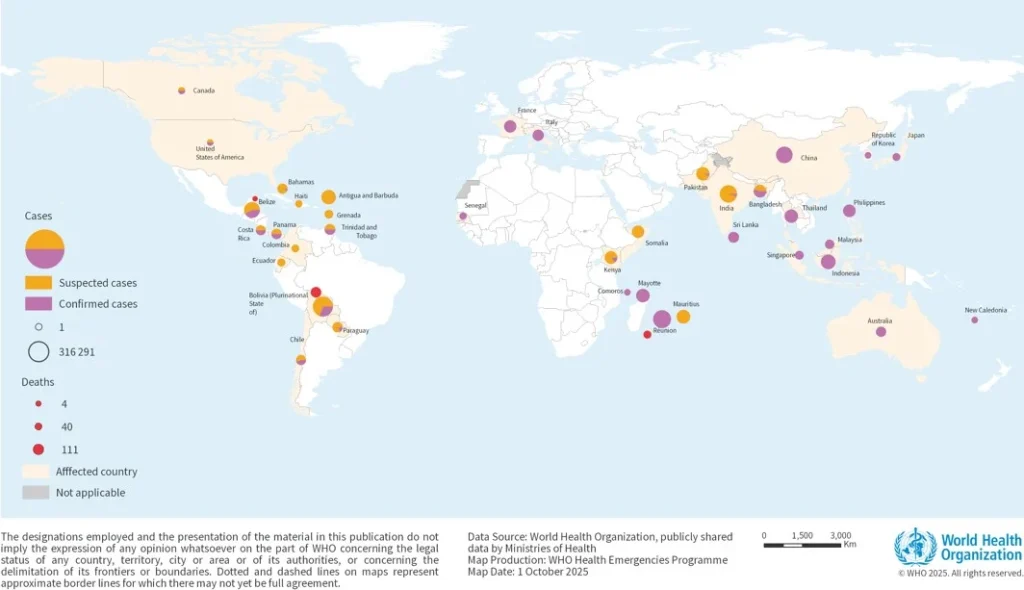A resurgence of chikungunya virus (CHIKV) disease has been reported across 40 countries in 2025, marking a significant uptick in transmission after several years of relative decline.
The World Health Organisation (WHO) reported that between 1 January and 30 September 2025, a total of 445,271 suspected and confirmed cases and 155 deaths were recorded globally.
In a document obtained by New Daily Prime, the region of the Americas and the Indian Ocean islands have reported the highest case numbers, with Brazil and La Réunion accounting for the majority of infections and deaths.
In the region of the Americas, transmission continues in line with seasonal trends, with 228,591 suspected cases, including 100,329 confirmed cases and 115 deaths, reported across 14 countries.
Read Also: NIMR urges better surveillance, advanced kits for VHF detection
Brazil remains the epicentre, contributing nearly 96 percent of all confirmed cases and deaths. Bolivia has also recorded more than 5,000 cases, with the outbreak largely concentrated in Santa Cruz Department, while Cuba has confirmed 34 cases across several provinces.

The Pan American Health Organization (PAHO) has issued an epidemiological alert and is supporting countries to strengthen integrated surveillance and vector control.
The European region, driven by outbreaks in the French overseas territories, has reported 56,456 cases and 40 deaths.
The island of La Réunion has experienced its first large-scale chikungunya outbreak since 2014, with more than 54,000 confirmed infections and 40 deaths recorded by mid-September.
While transmission on the island has shown signs of decline since April, neighbouring Mayotte has also seen local transmission following imported cases, reporting over 1,200 infections.
In mainland Europe, France and Italy have reported locally acquired cases across multiple clusters, reflecting the virus’s capacity to establish temporary footholds in temperate regions.
Elsewhere, countries in South-East Asia have reported over 34,000 cases, primarily in India, Bangladesh and Sri Lanka. India alone has recorded nearly 32,000 suspected infections.
The African region has reported limited but notable activity in Mauritius, Kenya, Senegal and Comoros, with Mauritius accounting for the majority of confirmed cases.
In the Western Pacific region, significant transmission has been observed in China’s Guangdong Province, where over 16,000 cases mark the country’s largest outbreak to date.
WHO says the uneven distribution of cases across regions makes it difficult to characterise the current situation as a uniform global surge, but warns that the risk of further spread remains high.
The agency attributes the resurgence to a combination of factors, including climate-driven expansion of Aedes mosquito habitats, increased human mobility, poor water management, and gaps in surveillance and vector control systems.
Chikungunya, a mosquito-borne viral disease transmitted primarily by Aedes aegypti and Aedes albopictus, causes fever and severe joint pain that can persist for months.
While the infection is rarely fatal, severe cases can occur among newborns, the elderly, and individuals with pre-existing health conditions.
WHO has urged countries to strengthen surveillance systems, enhance vector control, and build laboratory and healthcare capacities to detect and manage outbreaks swiftly.
The organisation emphasised that sustained community engagement and environmental management are essential to curb mosquito breeding and prevent future waves of transmission.
“Given the ongoing outbreaks reported globally in 2025, and the presence of Aedes mosquito the potential for further spread remains significant,” WHO warned. “Strengthening surveillance, enhancing vector surveillance and control, and improving public health preparedness are essential to mitigate the risk of further transmission.”



